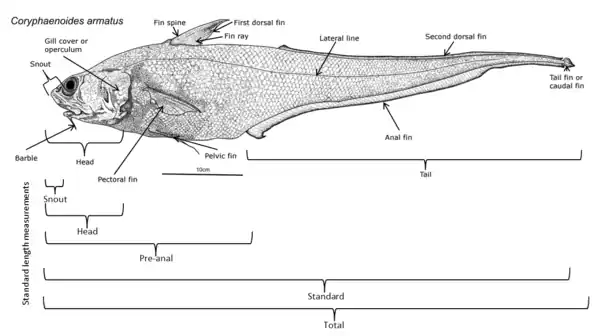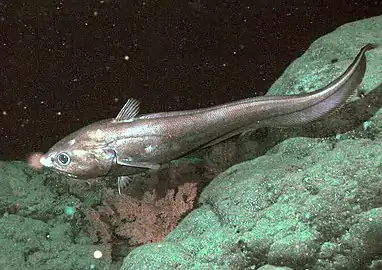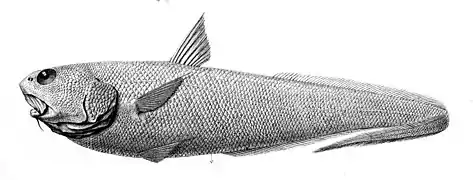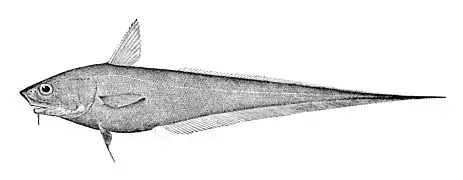Abyssal grenadier
The abyssal grenadier, Coryphaenoides armatus, is an abyssal fish of the genus Coryphaenoides, found in all the world's oceans, at depths between 800 and 4,000 metres (2,600 and 13,100 ft). Its adult length is 20 to 40 centimetres (8 to 16 in), although Fishbase[2] gives lengths up to 1 metre (3 ft 3 in). The abyssal grenadier's body is unique in that it contains two dorsal spines and about 124 dorsal soft rays, which are the flexible jointed rays supporting a fin nearest to the back in the spinal column. It has no anal spines, but has 115 anal soft rays along its body. The head and eyes of this fish are very large, while the mouth is very small. The color of the abyssal grenadier is brown apart from the abdomen, which is bluish.[3]
| Abyssal grenadier | |
|---|---|
 | |
| Abyssal grenadier, Coryphaenoides armatus | |
| Scientific classification | |
| Domain: | Eukaryota |
| Kingdom: | Animalia |
| Phylum: | Chordata |
| Class: | Actinopterygii |
| Order: | Gadiformes |
| Family: | Macrouridae |
| Subfamily: | Macrourinae |
| Genus: | Coryphaenoides |
| Species: | C. armatus |
| Binomial name | |
| Coryphaenoides armatus (Hector, 1875) | |
| Synonyms[2] | |
| |
Overview
Coryphaenoides armatus occurs at the deep-slope, on the upper continental rise between 2,000 m and 4,700 m.[4] However, they have been observed at depths between 282 m and 5180 m.[4] This depth range is dependent on the ocean as C. armatus lives in depths between 2000 and 4800 meters in the Atlantic and Indian Oceans but are limited to nutrient-dense environments between 2000 and 4300 meters in the Pacific Ocean.[5] Its diet changes as it matures, from benthic invertebrates such as crustaceans and holothuroids when young to mesopelagic and bathypelagic fish, sea urchins and cephalopods when adult. The sensory specialty of C. armatus also changes over its lifecycle; juveniles are more reliant on sight than olfaction, but developed adults are considered to be olfactory specialists.[6] Very few ripe females, and no spent individuals have been collected, and this is suggestive of this species being semelparous.[1] A study done on the influence of carrion supply in the role of temporal changes in grenadier abundance showed a direct positive correlation to amount of carrion and the population of abyssal grenadier in the eastern North Pacific.[7]
Feeding and hunting behavior
C. armatus' diet is mainly composed of mid-water cephalopods and fishes but can also consume echinoderms.[8] Examination of the stomach contents of specimens collected by trawling below 2,600 m deep in the Hudson Canyon showed that an important proportion of the diet of C. armatus is caught in the deep mesopelagic and bathypelagic regions. Though the diet of C. armatus largely consists of animals, these fish have been observed to opportunistically consume phytodetritus, especially in regions where phytodetritus falls are more common.[9] This finding was supported by researchers who found a positive correlation between increased swim speed in months with increased levels of benthic nutrient enrichment via marine snow.[10] Research studies focused on the feeding and foraging habits of C. armatus has revealed that this species follows an active foraging strategy consistent with the optimal foraging theory.[11] C. armatus has been observed to maintain low metabolic rates and slow aerobic activity in their foraging; these behaviors are thought to reflect a need to conserve energy due to the extreme environmental conditions and food scarcity that exists in C. armatus' natural habitats.[12]
 On the Davidson Seamount at 2253 meters depth
On the Davidson Seamount at 2253 meters depth- Coryphaenoides armatus is seen in this video describing the operation and use of an autonomous lander (RV Kaharoa) in deep sea research

 Abyssal grenadier, Coryphaenoides armatus
Abyssal grenadier, Coryphaenoides armatus
See also
References
- Fernandes, P.; Cook, R.; Florin, A.-B.; Lorance, P.; Nielsen, J. & Nedreaas, K. (2015). "Coryphaenoides armatus". IUCN Red List of Threatened Species. 2015: e.T18125776A60791529. doi:10.2305/IUCN.UK.2015-4.RLTS.T18125776A60791529.en. Retrieved 25 June 2023.
- Froese, Rainer; Pauly, Daniel (eds.) (2018). "Coryphaenoides armatus" in FishBase. February 2018 version.
- Cohen, D. M.; Inada, T.; Iwamoto, T.; Scialabba, N. (1990). Gadiform Fishes of the World. FAO Species Catalogue. Vol. 10. ISBN 92-5-102890-7.
- Ritchie, H.; Cousins, N. J.; Cregeen, S. J.; Piertney, S. B. (2013-12-15). "Population genetic structure of the abyssal grenadier (Coryphaenoides armatus) around the mid-Atlantic ridge". Deep Sea Research Part II: Topical Studies in Oceanography. ECOMAR: Ecosystems of the Mid-Atlantic Ridge at the Sub-Polar Front and Charlie-Gibbs Fracture Zone. 98: 431–437. doi:10.1016/j.dsr2.2013.06.014. ISSN 0967-0645.
- Jamieson, A. J.; Priede, I. G.; Craig, J. (2012-06-01). "Distinguishing between the abyssal macrourids Coryphaenoides yaquinae and C. armatus from in situ photography". Deep Sea Research Part I: Oceanographic Research Papers. 64: 78–85. doi:10.1016/j.dsr.2012.02.001. ISSN 0967-0637.
- Wagner, H.-J. (2003-04-01). "Volumetric analysis of brain areas indicates a shift in sensory orientation during development in the deep-sea grenadier Coryphaenoides armatus". Marine Biology. 142 (4): 791–797. doi:10.1007/s00227-002-0990-7. ISSN 1432-1793. S2CID 86117788.
- Drazen JC, Bailey DM, Ruhl HA, Smith KL Jr (2012) The Role of Carrion Supply in the Abundance of Deep-Water Fish off California. PLoS ONE 7(11): e49332. doi:10.1371/journal.pone.0049332
- Bailey, D. M.; Ruhl, H. A.; Smith, K. L. (March 2006). "Long-Term Change in Benthopelagic Fish Abundance in the Abyssal Northeast Pacific Ocean". Ecology. 87 (3): 549–555. doi:10.1890/04-1832. ISSN 0012-9658. PMID 16602284.
- Jeffreys, Rachel M.; Lavaleye, Marc S. S.; Bergman, Magda J. N.; Duineveld, Gerard C. A.; Witbaard, Rob (2011-04-01). "Do abyssal scavengers use phytodetritus as a food resource? Video and biochemical evidence from the Atlantic and Mediterranean". Deep Sea Research Part I: Oceanographic Research Papers. 58 (4): 415–428. doi:10.1016/j.dsr.2011.02.002. ISSN 0967-0637.
- Priede, I. G.; Ragley, P. M.; Smith, K. L. (March 1994). "Seasonal change in activity of abyssal demersal scavenging grenadiers Coryphaenoides ( Nematonums ) armatus in the eastern North Pacific Ocean". Limnology and Oceanography. 39 (2): 279–285. doi:10.4319/lo.1994.39.2.0279.
- Priede, Imants G.; Smith, Kenneth L.; Armstrong, John D. (1990-01-01). "Foraging behavior of abyssal grenadier fish: inferences from acoustic tagging and tracking in the North Pacific Ocean". Deep Sea Research Part A. Oceanographic Research Papers. 37 (1): 81–101. doi:10.1016/0198-0149(90)90030-Y. ISSN 0198-0149.
- Collins, M. A.; Priede, I. G.; Bagley, P. M. (1999-10-07). "In situ comparison of activity in two deep-sea scavenging fishes occupying different depth zones". Proceedings of the Royal Society of London. Series B: Biological Sciences. 266 (1432): 2011–2016. doi:10.1098/rspb.1999.0879. PMC 1690310.
Further reading
- Tony Ayling & Geoffrey Cox, Collins Guide to the Sea Fishes of New Zealand, (William Collins Publishers Ltd, Auckland, New Zealand 1982) ISBN 0-00-216987-8
External links
 Media related to Coryphaenoides armatus at Wikimedia Commons
Media related to Coryphaenoides armatus at Wikimedia Commons
